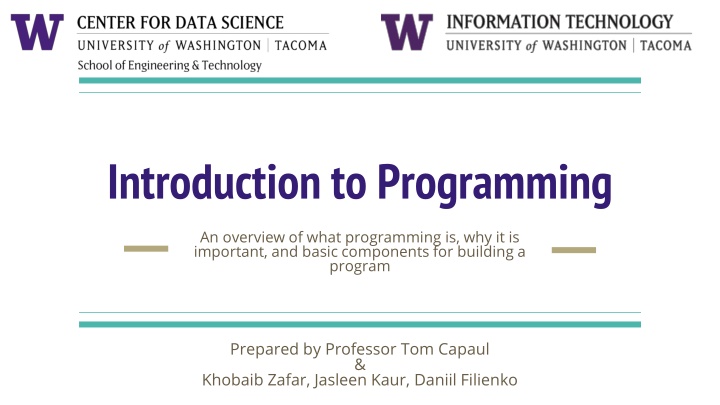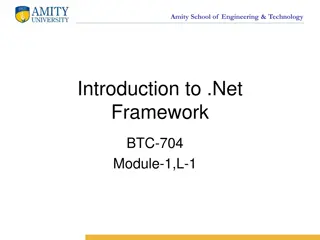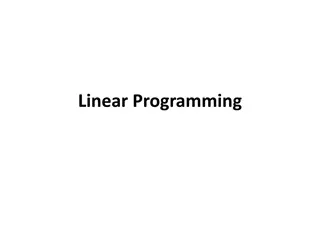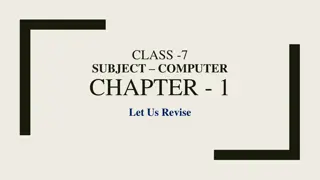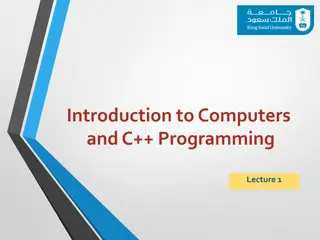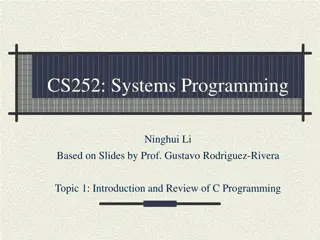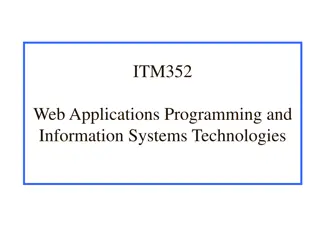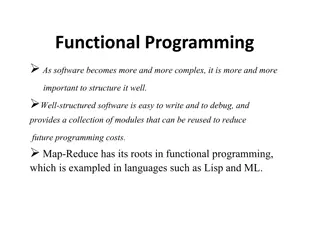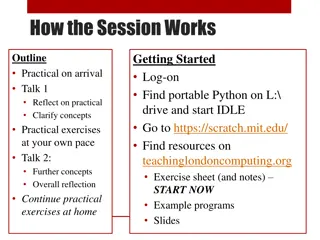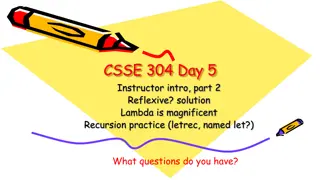Introduction to Programming
Programming is a fundamental skill that is essential in today's technology-driven world. This overview delves into the significance of programming and the basic components required to create a program. Learn from experts about coding, problem-solving, and the building blocks of software development. Dive into this comprehensive guide to gain insights into the world of programming and its applications in various fields.
Uploaded on Feb 23, 2025 | 1 Views
Download Presentation

Please find below an Image/Link to download the presentation.
The content on the website is provided AS IS for your information and personal use only. It may not be sold, licensed, or shared on other websites without obtaining consent from the author.If you encounter any issues during the download, it is possible that the publisher has removed the file from their server.
You are allowed to download the files provided on this website for personal or commercial use, subject to the condition that they are used lawfully. All files are the property of their respective owners.
The content on the website is provided AS IS for your information and personal use only. It may not be sold, licensed, or shared on other websites without obtaining consent from the author.
E N D
Presentation Transcript
Introduction to Programming An overview of what programming is, why it is important, and basic components for building a program Prepared by Professor Tom Capaul & Khobaib Zafar, Jasleen Kaur, Daniil Filienko
Programming - Why? Computers are used for different purposes and in different situations. But, how can they be so versatile? Answer: They can be programmed. The ability for a computer to be programmed allows it to do whatever their programs tell them what to do. A program is a set of instructions that tell a computer what to do. It is the translation of an algorithm (in English) to a language the computer can understand. A computer cannot do anything unless it has a program to tell it what to do.
What is an algorithm? A finite set of steps that describes how to solve a problem. It is a recipe: If you follow the recipe precisely, you ll get the same results every time for the same starting information. Think about a recipe for making a pepperoni pizza: There is a set of ingredients needed before putting the pizza together (we call it input). Other materials like a bowl, measuring utensils, a pan, pizza slicer, and an oven are required. The ingredients are combined in a specific order using the materials to produce the desired result (we call it output). We use algorithms every day for the things we do. Getting ready for the day Driving/Going to school Brushing your teeth
Programming - What? Programs are used to operate the components of a computer, solve problems or satisfy a want/need. How long will it take me to get home if I drive x miles per hour? I want to be able to tell my friends what I am doing right now. Computer Programming is both an Art and a Science. Every aspect of a program must be carefully designed. As an art, programming takes creativity and problem solving. There is often no one correct way to solve a problem. As a science, there are formal and proven methods to go about creating a program. There is often more or less efficient way to solve a problem. Indeed, writing a robust program (piece of software) can utilize many different individuals with different skill sets and points of view.
Programming - Who? Anyone can program. You do NOT need a Computer Science or related degree to be able to program. It is NOT just for Nerds and Geeks . Possible uses of programming: Business: Place formulas in a spreadsheet to tabulate results, compute averages, filter data. Yes! You are technically doing some programming when you utilize a built in formula in Excel. English: Use the Programming language Python to plot the occurrence/frequency of words in an essay. Biology: Use Python to plot birth and death rates of frogs from month to month in Costa Rica. Medicine: Use Python to plot daily blood pressure of patients over a three month period representing summer months.
Software Software refers to the programs that run on a computer. Some categories: Operating System (OS) A set of programs that manages a computer s hardware devices and controls their processes. Most modern operating systems are capable of running multiple programs at once. UNIX, Linux, Mac OS X, and Windows are examples. Application Software Programs that make the computer useful for the user. Solve specific problems or supply a service. Word processors, spreadsheets, databases, etc. Entertainment Games Multimedia etc.
Simple Programs Typically involve three fundamental components Input The data on which operations will be performed Processing of the input Applying necessary operations to transform the input into the desired output Output The result of processing the input Might be displayed to the screen, saved to a database, or sent across the network to another computer Require the following concepts to perform their tasks Variables Decisions/Branching/Conditionals Repetition/Loops Read input Display output
Variable A value that can change depending on conditions or information passed to the program Typically represented by a specific type, depending on the information you want to represent A student s age in years might be represented as an integer value (1, 2, 3, 99, 100) A student s gpa might be represented as a real number (3.98, 2.88, etc.) The name of a student might represented as a string (a collection alphabetic letters, for example) Daniil Zafar Jasleen There are many other data types that can be used depending on a program s needs Date Time Boolean (something that can be true or false) List (a collection of some other data type) A University Class might have a list of student IDs
Decisions/Branching/Conditionals Provide a means to take a specific action based on what some data currently looks like If condition is true, then do something If the thermostat reads below 68 degrees Fahrenheit, then turn on the heat Once the temperature reaches 68 degrees, turn the heat off If the thermostat reads above 80 degrees Fahrenheit, then turn on the AC Once the temperature drops to 80 degrees, turn the AC off Called branching because the program will branch to a particular portion of the code based on the result of evaluating a condition If the thermostat reads below 68 degrees Turn on the heat Note that if the temperature is not below 68, the heat does not get turned on, so turning the heat on is a branch Conditionals involve the use of a Boolean operations (something that evaluates to true or false) If we have a variable called current_temperature, we can compare it against the value 68 and get a Boolean result: if current_temperature < 68
Repetition/Loops Some operations in a program might need to be repeated Usually operations are repeated a specific number of times, but there are some cases where something might be repeated forever (some games will let you play again and again and again, potentially forever, unless you choose to quit) Programs use loops to implement repetition Loops require a Boolean (something that evaluates to true or false) to decide whether to repeat a set of operations Computing the average quiz score for a class requires a loop As long as there is a quiz score to read: Read the current quiz score Add that quiz score to the total of quiz scores so far Increment the count of quizzes read Calculate the average by dividing the total of quiz scores by the count of quizzes read Display the average to user
Input and Output A program needs to obtain the input that needs processed Some places the input can come from Keyboard Mouse File Database Network (over Wifi) A program needs to display output Output is typically displayed to the screen of the computing device Text based output Graphical User Interface (GUI) output Images Text
Sample Program Suppose we want to calculate the average of a set of test scores, and then also determine the high score First, we will create an algorithm (in English) to do this Then, we will then translate that algorithm to a programming language (Python) and run it
Algorithm for average test score and highest test score If there are 1 or more test scores: Read the first test score Mark first test as highest-scored test Store its value Record that one test was checked Read subsequent test scores If its score is greater than current highest-scoring test, mark it as a new highest-scored test Add its value to the sum of scores of previous tests Increase the value of checked tests by 1 After all of test scores have been read Output the highest-scoring test Divide the sum of the test scores by the number of tests that you read
Interactive Python Code https://ide.geeksforgeeks.org/ Choose Python3 in the language list Copy and paste the text in the attached document to the IDE
